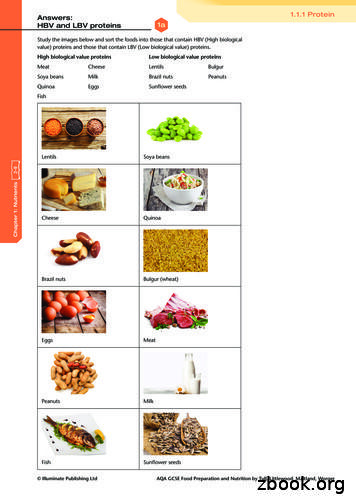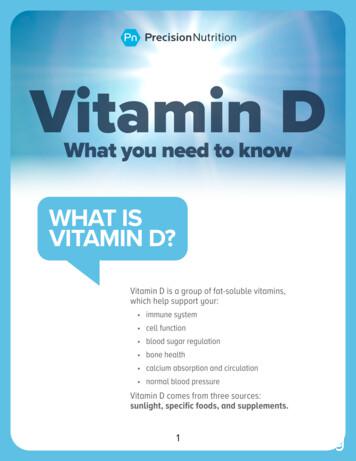Diagnosis And Management Of Vitamin B12 Disorders
Diagnosis and management ofvitamin B12 disordersSimona DeplanoConsultant HaematologistHammersmith HospitalLondon UK
Learning objectives (1) Review the epidemiology of vitamin B12deficiency Review the causes of vitamin B12 deficiency Describe the clinical features of vitamin B12deficiency Review the diagnostic pathway of vitamin B12deficiency Review the management of patients withvitamin B12 deficiency
Learning objectives (2) Review the epidemiology of high vitamin B12 Review the pathophysiology of high serumvitamin B12 in clinical practice Review the management of patients with highvitamin B12
Vitamin B12 Also called cobalamin, is a water-soluble vitaminwith a key role in the normal functioning of the brainand nervous system and for the formation of blood cells. It is involved in the metabolism of every cell of thehuman body, affecting DNA synthesis and regulationbut also fatty acid synthesis and energy production.
Vitamin B12 functions
Daily vitamin B12 requiremento Only source available to man is dietary(liver, kidney, red meat, eggs, shellfish anddairy products).o Normal mixed diet contains 5-30 μg /day.o Typical daily losses 1-4 μg (lost mainly inurine and faeces).o Since normally there is no consumption ofvitamin B12 within the body, the dailyrequirement matches daily losses.
Vitamin B12 storeso Normal body stores of vitamin B12about 3-4 mg, primarily in liver.o This would be sufficient for 3 yearsif dietary intake ceased or if theability to absorb the vitamin waslost.
Vitamin B12 absorptiono Vitamin B12 forms a complex withintrinsic factor (IF) in the stomach.o IF is a glycoprotein synthesized andsecreted by gastric parietal cells.o IF: B12 complex then progresses to theileum where it attaches to specificreceptors on the ileal mucosal cells.o The vitamin is internalized from thecomplex and released into the portalcirculation after 6 hours.
Vitamin B12 transport The transport of vitamin B12 in the blood as wellas its hepatic and tissue uptake require thepresence of TRANSCOBALAMINS (TCBs) TCB I and III ensure the binding of 80% ofcirculating B12 TCB II plays the predominant role in tissue andhepatic uptake of vitamin B12 Congenital absence of TCB II causes severeanaemia within weeks of birth
Vitamin B12 transport
Tests to assess vitamin B12 status Serum cobalamin ( 148 pmol/l)(low cost, widely available) Plasma Methylmalonic acid(high cost test, falsely elevated in pts withrenal disease) Serum Holotranscobalamin(very sensitive but not available in most labs) Plasma homocysteine ( 15 μmol/l)(elevated in pts with renal failure)
Vitamin B12 deficiencyEpidemiologyPrevalence varies by age groups andincreases with age 1% in infants and children 3-5% in young adults Up to 20% in elderly patients
Causes of vitamin B12 deficiency Intestinal malabsorption Inadequate dietary intake Increased requirements, which cannotbe met from the diet Failure of utilization of absorbedvitamin
Causes of vitamin B12 deficiencydivided by age groupsAll agesInfectionsMalabsorptionMedical conditions (Crohn’s disease, gastricresection)Inadequate dietary intakeInfants andchildrenGenetic disorders(Transcobalamin deficiency)Inadequate maternal dietary intakeWomen of childbearing agePregnancy and lactationOlder personsMalabsorption(Achloridia due to atrophic gastritis andproton pump inhibitors
Who is at risk? Strict vegetarians who eat NO animal foodand their infants Elderly people as B12 uptake abilitydecreases with age
Inadequate dietary intakeThis is uncommon for three main reasons: Vitamin B12 is present in a wide range ofreadily available foodstuffs. Vitamin B12 is relatively heat-stable. Body stores of vitamin B12 are sufficient tomeet the requirements for at least threeyears following complete cessation of dietaryintake or intestinal absorption.
Malabsorption of vitamin B12The most common cause of the deficiency,which could be due to: Lack of intrinsic factor Gastrointestinal disease Drug-induced Malabsorption
Megaloblastic anaemia Megaloblastic anemia is referred to a groupof panhypoplastic disorders, characterized byretardation of DNA synthesis while RNAsynthesis proceeds at a normal rate. The resulting asynchrony between nuclear andcytoplasm maturation in developing cells isresponsible for the distinctive morphologicaland biochemical features of megaloblasticanaemias.
Pernicious anaemia It is by far the most common cause of B12deficiency. It is especially common among the elderly. It is more common in women than in men andis associated with blood group A.
Pernicious anaemia Autoimmune atrophic gastritis 0.1% prevalence in the general population 1.9% in subjects over the age of 60 years Biologically characterised by the presence ofanti-IF antibodies
Clinical findingsClassic triad Sore tongue Weakness Paresthesias
Megaloblastic hematopoiesisRaised MCV 100 flAnaemia /- leukopenia /- ThrombocytopeniaCauses of cytopenias: Deranged DNA synthesis Ineffective hematopoiesis Shortened RBC survival
Other causes of macrocytosis Drugs affecting DNA synthesis(Hydroxyurea, methotrexate, zidovudine) Hepatic disease(Increased deposition of cholesterol andphospholipids on the membrane of circulating RBCs) Hemolytic anaemia (reticulocytosis) Alcoholism(direct effect on bone marrow) COPD(excess cell water secondary to carbon dioxideretention)
Blood film examination
Biochemical findings Raised LDH Raised indirect bilirubin Reduced haptoglobin Increased ferritin and serum iron
Effects of cobalaminreplacement Neurological response is unpredictable BM megaloblastic changes are lost in 1-3 days Reticulocytosis resolved in 5-8 days Neutrophil hypersegmentation lost in 1-2 weeks Hb normalises in 5-6 weeks MCV normalises in 10 weeks
Assessment of patients withsuspected vitamin B12 deficiency (1)Evaluation of diet Is patient vegan or vegetarian? Is patient anorexic or has poor diet?Personal or family history of autoimmune disease Does patient, parent or sibling have hypothyroidismor pernicious anaemia?History of parasthesiae, unsteadiness, peripheralneuropathy
Assessment of patients withsuspected vitamin B12 deficiency (2)Features of malabsorption Previous gastric surgery or small bowel resection?Drug history Prolonged protein pump inhibitors, metformin,contraceptive pillPregnancy
Strong suspicion of vitamin B12deficiency: what should I do?Pt with anaemia, glossitis, paraesthesiaVit B12 148 pmol/lCheck anti-IF AbsStart B12 replacementAnti-IF Abs veLifelong treatmentAnti-IF Abs –veIf clinical responseLifelong treatmentVit B12 148 pmol/lCheck anti-IF AbsCheck MMA and tHcyStart empirical B12replacement ve 2nd line testsLifelong treatmentNormal 2nd line testsConsider continuation treatment ifAnti-IF Abs ve or good responseTo initial treatment
Conclusions (1) There is no gold standard to define deficiency Serum cobalamin remains the 1st line test MMA and homocysteine can be used in case ofuncertainties of underlying deficiency In the presence of discordance between testresults and strong clinical picture of deficiency,treatment should not be delayed to avoidneurological impairment
Conclusions (2) All patients with anaemia, neuropathy orglossitis should be tested for anti IF absregardless of serum cobalamin levels Patients found to have positive anti IF absshould have lifelong therapy with cobalamin Patients negative for IF abs with no othercauses of deficiency should be treated asanti IF abs negative pernicious anaemia.Lifelong therapy should be continued in thepresence of an objective clinical response
Case report 136 year old maleFound unconscious on the floor of his flatNo signs of violenceNo medical hx availableNo drug hx available
Laboratoristic findings FBC: Hb 20 g/l; WCC 12.3; Neutr. 9.2; Plt 14;MCV 100 fl; Retic. 1.5% Clotting screen: PT 36.6 s; APTT 34.5 s; Fbg 2.5 g/l LDH 5600; Bil 108; ALT 1300; Creatinine 65 umol/l Urea 8.1 mmol/l B12 283 ng/l (160-800); serum folate 9.4 ug/l ( 2.7) Ferritin 4000 ug/l; Transferrin sat. 27% CRP 34
Blood film examination Macrocytosis Red cell fragments Hypersegmented neutrophils Tear drop cells
Differential diagnosisRed cell fragmentsThrombocytopeniaNeurologic manifestations?TTP
Additional tests Toxicologic testsneg Viral screenneg Anti-IF antibodiesneg ADAMS 137% Troponin Autoimmune screenneg
Bone marrow findings Erythroid hyperplasia Megaloblastic erythroid precursors
Management Plasma exchange B12 and folate replacement
Outcome Complete resolution of neurological manifestations Normalisation of FBC within a month Patient discharged after two weeks with noclinical sequelae Patient was a strict vegan !!!
Elevated Vitamin B12 levels:clinical significance and epidemiology Frequent and underestimated anomaly Clinically can be paradoxically accompaniedby signs of deficiency The aetiological profile encompasses severedisease entities for which early diagnosis iscritical for prognosis Prevalence of 12% in a retrospective studyby Deneuville et al. including 3702 hospitalisedpatients.
High vitamin B12 and cancer Association between elevated B12 and cancerfirst described in 1975 by Carmel et al. Carcinomas most frequently involved are HCCand metastatic colon, breast and pancreatic cancer. Chiche et al. showed that 23% of patients with highB12 had a previously unknown solid cancer in73% of cases, which was still at a non-metastaticstage in 80% of cases.
Transcobalamins TCB I and III are produced by granulocytes(Increased in myeloproliferative disorders)Apart from antibacterial role, their exact functionis not known. TCB II is primarily produced by hepatocytesbut also by endothelial, monocytic and intestinalcells.It is essential in the delivery of vitamin B12to cells and tissues.
Pathophysiology of high vitamin B12 Excess B12 intake Excess production of TCBs(liver disease, MPD, neoplasms, inflammation) Defect in clearance of TCBs(Renal failure, anti TCB antibodies) Congenital deficiency in TCBs Defect in TCB-B12 affinity Hepatic release of B12 and TCBs(Liver disease)
Excess vitamin B12 intake Ingestion of multivitamin complex tablets(often not spontaneously reported!!!) Parenteral administration of vitamin B12(more frequent in the past when Schilling testwas available)
High vitamin B12 andsolid neoplasms Carcinomas most frequently involved are:hepatocellular carcinoma and secondaryliver tumours Correlation between size of tumors and degreeof elevation of vitamin B12 Primary mechanisms implicated:1) increased levels of TCBs due to excessdegradation of hepatocytes2) decreased hepatic clearance of HC-cobalamincomplex
High vitamin B12 andblood disorders High vitamin B12 is frequently observed inmyeloproliferative disorders (CML, PV, MF) A statistically significant association was foundbetween vitamin B12 levels 1275 pg/ml andhaematological malignancies. The elevated B12 levels in myeloid neoplasmsare primarily linked to the increased productionand release of TCBs by tumour granulocytes.
High vitamin B12 andliver diseases Acute liver disease (hepatitis)(excess release of B12 by the liver) Chronic liver disease (cirrhosis)(the degree of elevated vitamin B12 iscorrelated with the severity of cirrhosis) Alcoholic liver disease(increase in plasma levels of TCB I and IIIand decrease in TCB II)
Other causes of high vitamin B12 Renal failure (serum accumulation of TCBs) Autoimmune conditions (SLE, RA) Inflammatory diseases(increased release of TCB II)
High vitamin B12: clinical approachExcess intake?Multivitamin complex?Blood disorderFBCRenal failure?Renal profileAetiological searchSolid neoplasm?Physical examinationChest x-rayUS abdomen and pelvisOther tests according topatient’s symptoms and clinical signsInflammatorydisease?ESR, CRPLiver disease?LFTs
Conclusions High serum cobalamin could represent an earlymarker of a variety of diseases, includingcancer. A codified approach is needed to determinethe potential indications of the search forexcess vitamin B12 and the approach to adoptupon discovery of high serum cobalamin.
Case report 2 45 year old lady Serum B12 1000 pg/ml on routine bloods No constitutional symptoms No significant PMH Heavy smoker (25-30 sigarettes daily) Drinks 20 Units of alcohol weekly Not on any regular medications
Investigations FBC unremarkable Biochemistry profile unremarkable Inflammatory markers negative Chest x-ray NAD US abdomen pelvis NAD
Follow up at six months Patient still asymptomatic Physical examination unremarkable
Investigations FBC unchanged Biochemistry profile unremarkable Inflammatory markers negative Serum B12 normal
Discussion Should we perform a CT total body inevery young patient with unexplainedelevated vitamin B12? How long do we need to follow them up for? What information should we deliver to thepatient? When should we check vitamin B12 levels?
Take home messageThe clinical picture is the most importantfactor to consider in assessing thesignificance of vitamin B12 status.We treat patients not numbers!!!
References Guidelines for the diagnosis and treatment of cobalamin andfolate disorders.Devalia et al.BJH,Vol 166, Issue 4, pages 496–513, August 2014 Elevated plasma vitamin B12 levels as a marker for cancer:a population-based cohort study.Arendt et al. J Natl Cancer Inst. 2013 Dec 4;105(23):1799-805 Vitamin B12 transport from food to the body’s cellsa sophisticated, multistep pathway.Nielsen MJ et al. Nat Rev Gastroenterol Hepatol. 2012;9(6):345–354 High serum cobalamin levels in the clinical setting—clinical associationsand holo-transcobalamin changes.Carmel R et al. Clin Lab Haematol. 2001;23(6):365–371. Clinical implications of high cobalamin blood levels for internal medicineChiche L et al. Rev Med Intern. 2008;29(3):187–194.
Thank you
Evaluation of diet Is patient vegan or vegetarian? Is patient anorexic or has poor diet? Personal or family history of autoimmune disease Does patient, parent or sibling have hypothyroidism or pernicious anaemia? History of parasthesiae, unsteadiness, peripheral neuropathy Assessment of patients with suspected vitamin B12 deficiency (1)
Konsumsi asam folat, vitamin B12 dan vitamin C pada ibu hamil tergolong masih rendah, sehingga konsumsi sumber vitamin perlu ditingkatkan untuk mencegah masalah selama kehamilan, seperti anemia, prematur, dan kematian ibu dan anak. Kata kunci: asam folat, ibu hamil, vitamin B12, vitamin C *Korespondensi: Telp: 628129192259, Surel: hardinsyah2010@gmail.com J. Gizi Pangan, Volume 12, Nomor 1 .
Milk Thistle Red Clover Rhodiola St. John’s Wort Soy Bean Tomato Tribulus Terrestris Willow Vitamin B1 Vitamin B2 Vitamin B6 Vitamin B12 Vitamin C Vitamin D3 Vitamin E MISCELLANEOUS Alpha Lipoic Acid Beta Carotene Caffeine Choline Bitartrate Chond. Sulphate Bovine Chond. Sulphate Porcine Ch
Normal vitamin D 36% 9% 55% Vitamin D deficiency* Severe vitamin D deficiency** Normal vitamin D Camargo CA, Jr., Ingham T, Wickens K, et al. Vitamin D status of newborns in New Zealand. Br J Nutr 2010;104:1051 -7. Grant CC, Wall CR, Crengle S, Scragg R. Vitamin D deficiency in early childhood Public Health Nutr. 2009;12(10):1893-1901
25-OH Vitamin D levels* To determine vitamin D status * Only measure if patient is symptomatic and has risk factors for Vitamin D deficiency. Measurement, status and management (see Appendix 1 for flowchart) Vitamin D level Vitamin D status Health effect Management 30 nmol/L Defi
VITAMIN A This vitamin helps your body maintain healthy eyes and skin. VITAMIN C This vitamin helps the body heal cuts and wounds and maintain healthy gums. VITAMIN E This vitamin helps maintain healthy cells throughout your body. WATER Water makes up more than half of your body weight. Your
Vitamin A Keeps the skin healthy Helps us see in dim light Helps children to grow Keeps mucous membranes moist and healthy This vitamin is an antioxidant Vitamin D Helps calcium to be absorbed in the body Helps calcium to strengthen the bones and teeth Vitamin E This vitamin is an antioxidant Vitamin K Helps the blood.
important.1 But the form of the vitamin D in it is. Look for supplements that contain: Vitamin D3, which is superior at optimizing and maintaining vitamin D levels long-term2 3 Or, if you prefer a plant-based option: Vitamin D2, which is derived from yeast or mushrooms For best absorption, take vitamin D with a meal, especially one that .
VITAMIN D3 VITAMIN D2 Ergosterol Not produced in humans 1/3 activity D3 7-dehydrocholesterol Produced by skin by UVB Fully active 16 VITAMIN D3 1,25(OH) 2VITAMIN D 3 VITAMIN D3 Biologically inactive Does not bind to VDR Nutritional substance 1,25(OH) 2 D 3 Steroid hormone Acts through Vitamin D Receptor (VDR) 17






















